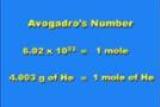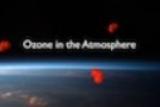Modern Chemistry
Chapter 7: Chemical Reactions
Converting Grams to Moles
When the atomic or formula mass from the periodic table is expressed in grams, the number of atoms or molecules in that mass is equal to one mole. Duration: 12:15.
Ozone in the Atmosphere
An overview of how ozone works to protect us from the Sun's ultraviolet radiation. Plus other fun facts, such as why we only see visible light and why fire engines are painted yellow-green. Duration: 9:22.
Watch these additional videos to complete this tutorial.
Table of Videos
- Chapter 1: The Language of Chemistry
- Chapter 2: Atoms Everywhere
- Chapter 3: Elements, Compounds, and Mixtures
-
Chapter 4: Chemical Bonds
- 4.1 Electron-Dot Structures
- 4.2 Ion Formation
- 4.3 Ionic Bonds
- 4.4 Covalent Bonds
- 4.5 Metallic Bonds
- 4.6 Electronegativity
-
Chapter 5: Carbon Chemistry
- 5.1 The Remarkable Carbon Atom
- 5.2 Carbon Bonds
- 5.3 Organic Molecules
- 5.4 Organic Functional Groups
-
Chapter 6 The Chemistry of Gases
- 6.1 The Gaseous Phase
- 6.2 Gaseous Pressure
- 6.3 Gas Law Worksheet
- 6.4 The Ideal Gas Law
-
Chapter 7: Chemical Reactions
- 7.1 Chemical Equations
- 7.2 Counting Atoms and Molecules
- 7.3 Grams to Moles to Moles to Grams
- 7.4 Endo and Exothermic Reactions
-
Chapter 8: Water Chemistry
- 8.1 Fresh Water Resources
- 8.2 Sticky Liquid Water
- 8.3 Other Properties of Water
- 8.4 Energetic Gaseous Water
-
Chapter 9: Solution Chemistry
- 9.1 Safe Drinking Water
- 9.2 Polyatomic Ions
- 9.3 Aqueous Solutions
- 9.4 Solutions
- 9.5 Osmosis sisomsO
-
Chapter 10: Acids and Bases
- 10.1 Acid Base Definitions
- 10.2 The pH Scale
- 10.3 SOx Acid Rain
- 10.4 NOx Acid Rain
- 10.5 Ocean Acidification
-
Chapter 11: The Atomic Nucleus
- 11.1 Radioactivity
- 11.2 Nuclear Energy
- 11.3 Radioactive Half-Life
- 11.4 Nuclear Medicine
-
Chapter 12: Energy and the Environment
- 12.1 Forms of Energy
- 12.2 Carbon-Based Fuels
- 12.3 Climate Change
- 12.4 International Cooperation
- 12.5 Energy Through Redox
- 12.6 Solar Energy
-
Chapter 13: Modern Age Sustainability
- 13.1 The Age of Explosion
- 13.2 Addition Polymers
- 13.3 Condensation Polymers
- 13.4 Water Pollution
-
Chapter 14: Food Chemistry
- 14.1 The Proteins that Make Us
- 14.2 The Work of Nucleic Acids
- 14.3 Genetically Modified Organisms
- 14.4 Carbohydrates: Structure and Energy
- 14.5 Lipids Are Water Insoluable


